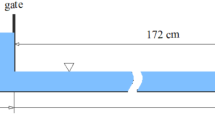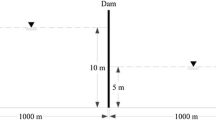Abstract
This paper aims to evaluate the effects of the opening width of a dam site on the evolution of partial dam-break waves over a fixed dry bed. The volume of fluid (VOF) method was used to scrutinize the propagation of the dam-break free surface. The model was validated using experimental data provided in the literature. At the same time, a sensitivity analysis was conducted on the size of the mesh cells and the turbulence model. However, the large eddy simulation (LES) method showed the highest accuracy among all the models. The results affirmed the crucial role of the opening width of the dam site in the flow characteristics. In this direction, diminishing the opening width results in a reduction of the wave-front travel distance, free surface gradient within the reservoir, outflow discharge values, damping the outflow hydrographs and decreasing the Froude number values at the dam site. Conversely, this leads to an increase in the air bubbles entrained within the wave and results in energy dissipation across the downstream channel.







Similar content being viewed by others
References
Bahmanpouri F, Daliri M, Khoshkonesh A, Montazeri Namin M, Buccino M (2020) Bed compaction on dam break flow over erodible bed; experimental and numerical modeling. J Hydrol 125645. https://doi.org/10.1016/j.jhydrol.2020.1256452020.125645
Bayon A, Valero D, García-Bartual R, Vallés-Morán FJ, López-Jiménez PA (2016) Performance assessment of OpenFOAM and FLOW-3D in the numerical modeling of a low Reynolds number hydraulic jump. Environ Model Softw 80:322–335
Bellos CV, Soulis JV, Sakkas JG (1992) Experimental investigation of 2-dimensional dam-break induced flows. J Hydraul Res 30(1):47–63
Biscarini C, Di Francesco S, Manciola P (2010) CFD modeling approach for dam break flow studies. Hydrol Earth Syst Sci 14:705–718
Cozzolino L, Cimorelli L, Covelli C, Della Morte R, Pianese D (2015) The analytic solution of the shallow-water equations with partially open sluice-gates: the dam-break problem. Adv Water Resour 80:90–102
Crespo AJC, Gomez-Gesteira M, Dalrymple RA (2009) Modeling dam-break behavior over a wet bed by an SPH technique. J Waterway Port Coast Ocean Eng 134(6):313–320
Crowder DW, Diplas P (2002) Vorticity and circulation: spatial metrics for evaluating flow complexity in-stream habitats. Can J Fish Aquat Sci 59:633–645
Fennema RJ, Chaudhry MH (1990) Explicit methods for 2D transient free surface flows. J Hydraul Eng 116(8):1013–1034
Flow Science (2012) Flow-3D user manual. Flow Science Ltd
Fraccarollo L, Toro EF (1995) Experimental and numerical assessment of the shallow water model for two-dimensional dam-break type problems. J Hydraul Eng 33(6):843–864
Haltas I, Elçi S, Tayfur G (2016) Numerical simulation of flood wave propagation in two-dimensions in densely populated urban areas due to dam break. Water Resour Manag 30(15):5699–5721
Hirt CW, Nichols BD (1981) Volume of fluid (VOF) method for the dynamics of free boundaries. J Comput Phys 39(1):201–225
Issakhov A, Zhandaulet Y (2020) Numerical simulation of dam break waves on movable beds for complex terrain by volume of fluid method. Water Resour Manag 34:463–480
Jones WP, Launder BE (1972) The prediction of laminarization with a two-equation model of turbulence. Int J Heat Mass Transf 15:301–314
Kalita HM (2020) A numerical model for 1D bed morphology calculations. Water Resour Manag 34(15):4975–4989
Khayyer A, Gotoh H (2010) On the particle-based simulation of a dam break over a wet bed. J Hydraul Res 48(2):37–41
Khoshkonesh A, Nsom B, Gohari S, Banejad H (2019) A comprehensive study on dam-break flow over dry and wet beds. Ocean Eng 188:106279
Kleefsman KMT, Fekken G, Veldman AEP, Iwanowski B, Buchner B (2005) A volume-of-fluid based simulation method for wave impact problems. J Comput Phys 206:363–393
Larocque LA, Imran J, Chaudhry MH (2013) 3D numerical simulation of partial breach dam-break flow using the LES and k -ε turbulence models. J Hydraul Res 51(2):145–157
Lee KH (2019) Simulation of dam-breach outflow hydrographs using water level variations. Water Resour Manag 33(11):3781–3797
Liu H, Liu H, Guo L, Senxun LU (2017) Experimental study on the dam-break hydrographs at the gate Location. J Ocean Univ China 16(4):697–702
Lobovský L, Botia-Vera E, Castellana F, Mas-Soler J, Souto-Iglesias A (2014) Experimental investigation of dynamic pressure loads during dam break. J Fluids Struct 48:407–434
Marsooli R, Wu W (2014) 3-D finite-volume model of dam-break flow over uneven beds based on VOF method. Adv Water Resour 70:104–117
Nsom B, Jenny M, Askoura Y, Peron F (2007) Numerical solution to horizontal zero- inertia, viscous dam-break problem. Innov Adv Tech Comput Inf Sci Eng (1):123–128. https://doi.org/10.1007/978-1-4020-6268-1_23
Ozmen-cagatay H, Kocaman S (2010) Dam-break flows during initial stage using SWE and RANS approaches Dam-break flows during initial stage using SWE and RANS approaches. J Hydraul Res 48:603–611
Pilotti M, Tomirotti M, Valerio G, Bacchi B (2010) Simplified method for the characterization of the hydrograph following a sudden partial dam break. J Hydraul Eng 136(10):693–704
Qian H, Cao Zh, Liu H, Pender G (2017) New experimental dataset for partial dam-break floods over mobile beds. J Hydraul Res 56(1):124–135
Soares-Frazo S et al (2012) Dam-break flows over mobile beds: experiments and benchmark tests for numerical models. J Hydraul Res 50(4):364–375
Stansby PK, Chegini A, Barnes TCD (1998) The initial stages of dam-break flow. J Fluid Mech 374:407–424
Tsakiris G, Spiliotis M (2013) Dam-breach hydrograph modelling: an innovative semi-analytical approach. Water Resour Manag 27(6):1751–1762
Versteeg HK, Malaskekera W (2007) An introduction to computational fluid dynamics. Fluid flow handbook. McGraw-Hill, New York
Xia J, Lin B, Falconer RA, Wang G (2010) Modelling dam-break flows over mobile beds using a 2D coupled approach. Adv Water Res 33(2):171–183
Yang S, Yang W, Qin S, Li Q, Yang B (2018) Numerical study on characteristics of a dam-break wave. Ocean Eng 159:358–371
Zhou Z, Wang X, Sun R, Ao X, Sun X, Song M (2014) Study of the comprehensive risk analysis of dam-break flooding based on the numerical simulation of flood routing. Part II: model application and results. Nat Hazards 72(2):675–700
Acknowledgments
The authors would appreciate the scientific support of Université de Bretagne Occidentale – UBO, Brest, France from all parts of this study.
Author information
Authors and Affiliations
Corresponding author
Ethics declarations
Ethics Approval
Not applicable.
Consent to Participate
Not applicable.
Consent for Publication
Not applicable.
Conflict of Interests
The authors affirm that there is no conflict of interest concerning the publication of this paper.
Additional information
Publisher’s Note
Springer Nature remains neutral with regard to jurisdictional claims in published maps and institutional affiliations.
Rights and permissions
About this article
Cite this article
Khoshkonesh, A., Nsom, B., Bahmanpouri, F. et al. Numerical Study of the Dynamics and Structure of a Partial Dam-Break Flow Using the VOF Method. Water Resour Manage 35, 1513–1528 (2021). https://doi.org/10.1007/s11269-021-02799-2
Received:
Accepted:
Published:
Issue Date:
DOI: https://doi.org/10.1007/s11269-021-02799-2




